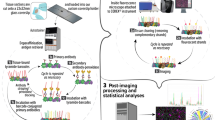Abstract
Purpose
The family of cathepsin proteases plays an important physiological role in both normal physiology and in the physiology of many human diseases. This activity, which is upregulated in many cancers, can be exploited for tumor imaging both in vivo and ex vivo. To characterize the behavior of a topically applied quenched fluorescent activity-based probe, GB119, ex vivo, we developed a basic immunohistochemistry technique to identify unquenched GB119 within tissue.
Procedures
Immunoblot assays were used to validate the utility of an anit-Cy5 antibody for the detection of unquenched GB119 generated by cathepsin-L. Following validation of the anti-Cy5 antibody, an immunohistochemical procedure was developed to detect the presence of unquenched GB119 in frozen sections of brain tumors derived from an orthotopic mouse model.
Results
These studies demonstrate that the anti-Cy5 antibody preferentially recognizes unquenched GB119 and that this differential can be used to identify the regions within the brain and the tumor that contained unquenched GB119. Using H&E staining and antibodies against other biochemical markers, it was further determined that unquenched GB119 was localized to the peri-tumor space and co-localized with cathepsin-L expression.
Conclusion
Our data indicate that this methodology allows high-resolution detection of unquenched GB119 that can be correlated with other immunohistological stains.






Similar content being viewed by others
Explore related subjects
Discover the latest articles and news from researchers in related subjects, suggested using machine learning.References
Reiser J, Adair B, Reinheckel TJ (2010) Specialized roles for cysteine cathepsins in health and disease. J Clin Invest 120:3421–3431
Brömme D, Wilson S (2011) Role of cysteine cathepsins in extracellular proteolysis. In: Parks WC, Mecham RP (eds) Biology of extracellular matrix, vol 2. Springer, Berlin, pp 23–51
Mohamed MM, Sloane BF (2006) Cysteine cathepsins: multifunctional enzymes in cancer. Nat Rev Cancer 6:764–775
Palermo C, Joyce JA (2008) Cysteine cathepsin proteases as pharmacological targets in cancer. Trends Pharmacol Sci 29:22–28
Blum G, Weimer RM, Edgington LE et al (2009) Comparative assessment of substrates and activity based probes as tools for non-invasive optical imaging of cysteine protease activity. PLoS One 4:e6374
Rothberg JM, Bailey KM, Wojtkowiak JW et al (2013) Acid-mediated tumor proteolysis: contribution of cysteine cathepsins. Neoplasia 15:1125–1137
Edgington LE, Verdoes M, Ortega A et al (2013) Functional imaging of legumain in cancer using a new quenched activity-based probe. J Am Chem Soc 135:174–182
Serim S, Haedke U, Verhelst SH (2012) Activity-based probes for the study of proteases: recent advances and developments. Chem Med Chem 7:1146–1159
Blum G, von Degenfeld G, Merchant MJ et al (2007) Noninvasive optical imaging of cysteine protease activity using fluorescently quenched activity-based probes. Nat Chem Biol 3:668–677
Verdoes M, Edgington LE, Scheeren FA (2012) A nonpeptidic cathepsin S activity-based probe for noninvasive optical imaging of tumor-associated macrophages. Chem Biol 19:619–628
Cutter JL, Cohen NT, Wang J et al (2012) Topical application of activity-based probes for visualization of brain tumor tissue. PLoS One 7:e33060
Abe T, Wakimoto H, Bookstein R et al (2002) Intra-arterial delivery of p53-containing adenoviral vector into experimental brain tumors. Cancer Gene Ther 9:228–235
Rempel SA, Rosenblum ML, Mikkelsen T (1994) Cathepsin B expression and localization in glioma progression and invasion. Cancer Res 54:6027–6031
Blum G, Mullins SR, Keren K (2005) Dynamic imaging of protease activity with fluorescently quenched activity-based probes. Nat Chem Biol 1:203–209
Urano Y, Sakabe M, Kosaka N (2011) Rapid cancer detection by topically spraying a γ-glutamyltranspeptidase-activated fluorescent probe. Sci Transl Med 3:110ra–119ra
Hashimoto H, Tokunaka S, Sasaki M et al (1992) Dimethylsulfoxide enhances the absorption of chemotherapeutic drug instilled into the bladder. Urol Res 20:233–236
Haugen MH, Johansen HT, Pettersen SJ et al (2013) Nuclear legumain activity in colorectal cancer. PLoS One 8:e52980
Verdoes M, Oresic Bender K (2013) Improved quenched fluorescent probe for imaging of cysteine cathepsin activity. J Am Chem Soc 135:14726–1423
Acknowledgments
Special thanks to Dr. Wilson for support of these studies by training and loan of his slide scanner and to Joe Meyers for his help in figure generation. This study was supported by a grant from the Coulter Foundation and the NFCR to J.P.B.
Conflict of Interest
JPB and MB are associated with Akrotome Imaging Inc. as both board members and co-founders. Akrotome is a company devoted to creating optical ABPs for imaging. Portions of the technology described in this report probe and have been licensed by Akrotome from both Case Western Reserve and Stanford Universities. This does not alter the authors' adherence to all the MIB policies on sharing data and materials.
Author information
Authors and Affiliations
Corresponding author
Rights and permissions
About this article
Cite this article
Walker, E., Gopalakrishnan, R., Bogyo, M. et al. Microscopic Detection of Quenched Activity-Based Optical Imaging Probes Using an Antibody Detection System: Localizing Protease Activity. Mol Imaging Biol 16, 608–618 (2014). https://doi.org/10.1007/s11307-014-0736-1
Published:
Issue Date:
DOI: https://doi.org/10.1007/s11307-014-0736-1




